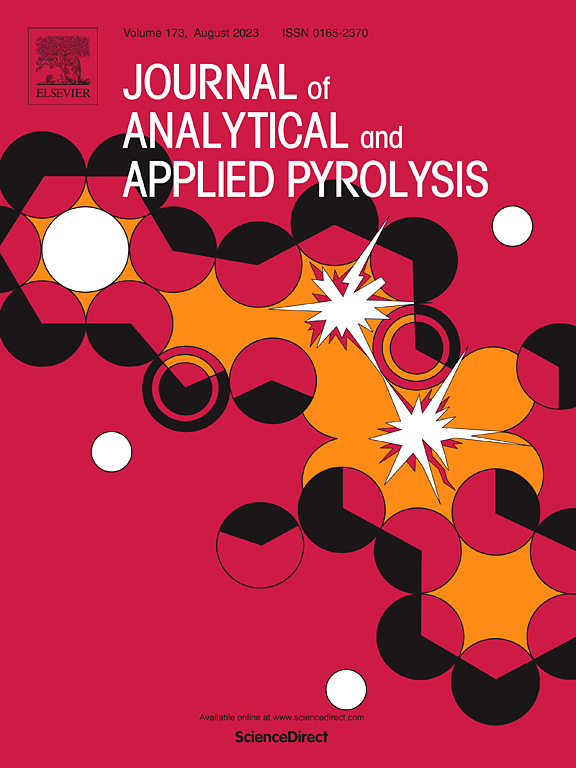通过实验和DFT模拟研究过硫酸铵的热危害及分解途径
IF 6.2
2区 化学
Q1 CHEMISTRY, ANALYTICAL
引用次数: 0
摘要
过硫酸铵(APS)是一种重要的过氧化物,广泛应用于许多工业领域。但是,如果在储存和运输过程中处于高温下,则可能发生剧烈的热分解反应,导致事故发生。因此,研究其热分解的热效应及相应的分解机理,有助于预测和控制热分解反应的发生,从而降低事故发生的风险。本文采用热重分析-差示扫描量热法(TG-DSC)、差示扫描量热法(DSC)和加速速率量热法(ARC)研究了APS的热分解特性。采用傅里叶变换红外光谱(FTIR)和热重分析-傅里叶变换红外光谱(TG-FTIR)对APS分解的固体和气态产物进行了研究。最后,结合实验研究,利用密度泛函理论(DFT)方法探索了热分解途径。结果表明,黄芪多糖的分解分为两个阶段。第一步是在200℃左右APS过氧化物键(O-O)断裂,为放热自催化反应,产物为O2和(NH4)2S2O7。第二步为(NH4)2S2O7在300-400℃的温度下分解,为吸热反应,最终分解产物为NH3、N2、SO2和H2O。根据ARC检测结果和风险矩阵评估标准,将APS归类为II级条件可接受危害。本工作为APS在实际化工过程中的安全生产、储存和使用提供了有益的信息。本文章由计算机程序翻译,如有差异,请以英文原文为准。
Investigation of thermal hazard and decomposition pathways of ammonium persulfate by experiments and DFT simulation
Ammonium persulfate (APS) is a very important peroxide that is widely used in many industries. However, if it is subjected to high temperatures during storage and transportation, it may undergo a violent thermal decomposition reaction, leading to accidents. Therefore, studying the thermal effect of its thermal decomposition and the corresponding decomposition mechanism is helpful for predicting and controlling the occurrence of the thermal decomposition reaction, thereby reducing the risk of accidents. In this work, thermal decomposition characteristics of APS were studied using thermogravimetric analysis - differential scanning calorimetry (TG-DSC), differential scanning calorimetry (DSC) and accelerating rate calorimeter (ARC). The solid and gaseous products of APS decomposition were investigated using fourier transform infrared spectroscopy (FTIR) and thermogravimetric analysis - fourier transform infrared spectroscopy (TG-FTIR). Finally, thermal decomposition pathways were explored using density functional theory (DFT) method combing with the experimental study. The results indicated that APS decomposition was divided into two stages. The fist step was the rupture of APS peroxide bond (O-O) at about 200, which was an exothermic self-catalytic reaction, and the products were O2 and (NH4)2S2O7. The second step was (NH4)2S2O7 decomposition at the temperature of 300–400 , which was an endothermic reaction, and the final decomposition products were NH3, N2, SO2 and H2O. According to the ARC test results and the risk matrix assessment criteria, APS was classified as level II conditional acceptable hazard. This work provides useful information for safe production, storage and use of APS in the practical chemical process.
求助全文
通过发布文献求助,成功后即可免费获取论文全文。
去求助
来源期刊
CiteScore
9.10
自引率
11.70%
发文量
340
审稿时长
44 days
期刊介绍:
The Journal of Analytical and Applied Pyrolysis (JAAP) is devoted to the publication of papers dealing with innovative applications of pyrolysis processes, the characterization of products related to pyrolysis reactions, and investigations of reaction mechanism. To be considered by JAAP, a manuscript should present significant progress in these topics. The novelty must be satisfactorily argued in the cover letter. A manuscript with a cover letter to the editor not addressing the novelty is likely to be rejected without review.

 求助内容:
求助内容: 应助结果提醒方式:
应助结果提醒方式:


